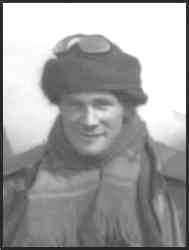

|
| Victor Carlstrom, 1916. |
|
1915 Among the first instructors were Victor Carlstrom and Walter Lees. They were also the first two aviators to take planes for a flight from Curtiss field on the afternoon of Dec. 29, 1915. Carlstrom flew an early Curtiss tractor biplane, while Lees piloted the hydro-aeroplane (flying boat). Lees flew over the city, circling back and forth like some huge bird. Carlstom did not attempt a lengthy flight, his machine being slightly out of order. Both aviators stated that the flights were successful from every standpoint. Roland Rohlfs, (18??-1974) began his career in 1914 as a mechanic with the Curtiss Aeroplane Company, first at Hammondsport and then Buffalo. Later he became a test pilot for Curtiss after learning to fly at their Newport News school with Victor Carlstrom as his instructor Howard J. Heindell failed to wake up on the morning of June 9, 1972. He was born in Oil City, Pa. August 3, 1896. He learned to fly at the Curtiss School in Newport News, VA in 1915. His instructors were Victor Carlstrom and Walter Lees. His first solo was July 4, 1915. His aviation career started with Curtiss in Hammondsport. He was Project Engineer at Garden City on the NC Transatlantic Flying Boats. He is survived by his wife Mabel, two sons, a daughter and six grandchildren. 1916 April 19. Victor flying an R-2, established a three-man American altitude record of 11,180 feet at Newport News, Virginia. Editor's Note: The specifications for and a photo of the Curtiss Model R may be found on the Aero Data Files site. Use your "Find" button and look for R, R-2 May. Carlstrom was the winner of a 28-mile aeroplane race at Sheepshead Bay, New York. His time was 14 minutes 21 seconds. Ruth Law, one of the few female flyers, came in third, flying a tiny Curtiss biplane with a 30-foot wingspan. Her time was 18 minutes, 16 seconds. 1917 While an instructor at Curtiss, Victor set world's records for speed and distance in the flight of a modified Jenny from Curtiss Field to New York Vic Carlstrom flew the big 200 h.p. Curtiss biplane called "The New York Times" to Newport News one day, the one he had flown in a race from Chicago to Governor's Island, New York in eight and one-half hours. He was going to take his brother Carl, who had come on from his ranch in Wyoming to learn to fly, for a hop in it. But something went wrong and he crashed in shallow water before our startled eyes. It was a sorry sight to see the big plane sink into the water with the name "New York Times" slowly disappearing under the waves 1917 Carl was to be Vic's student that winter and so was Carey Epes, a very pleasant young chap with whom we used to chat at the teller's window at the bank at Newport News. He was at the field every Sunday to watch the flying. He soon resigned his bank job to enlist in the army flying corps and considered himself lucky to be assigned to Vic Carlstrom for instruction. But sadly, in his first trip up when flying at about 3000 feet, something happened. The machine gave a terrific shudder and one of the big wings was torn off. The plane somersaulted to earth and crashed with the speed of a bullet, crushing pilot and student before the eyes of horrified spectators. 1917 Walter was very lucky while instructing for Curtiss. He never cracked up a plane, and never had a student crack up. Some of the other instructors weren't so lucky. Vic Carlstrom was killed. He and a student, Carey B. Epes, were up to about 1000 feet when the plane folded up and plunged to earth. When a plane "folded up". it was likely some of the bracing wires broke and the wings folded up, broke off, or trailed behind the airplane. Carlstrom's crash would be like falling off a 1000-foot high bridge. Instructor Walter Lees was just coming out of the hanger when Carlstrom's Jenny dived nose-first into the field. "I rushed to the plane," Lees told a Daily Press reporter, "to pull them out. There was no fire, but the nose of the plane was buried three feet into the ground. Both of them were cut pretty bad, and blood was everywhere. Neither of them moved, but I coudn't tell whether they were dead or just knocked out. When we got them out, we knew they were dead. It was a shock. Vic had been one of my closest friends. We had been laughing and joking just before he went up." 

|